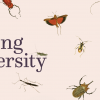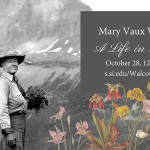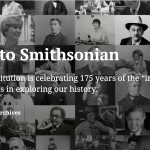Celebrate the vast and varied insect world through the pages of early illustrated natural history books! Through works spanning from the late 1700s to the early 1900s, Dazzling Diversity provides a glimpse into the wealth of recorded scientific knowledge in their pages and highlights the continuing relevance of historical science to contemporary biodiversity research. On display in the National Museum of Natural History through December 16, 2025.
Smithsonian Libraries and Archives Names Wesley Chenault Associate Director for Strategic Initiatives and Programs
Wesley Chenault has been appointed Associate Director for Strategic Initiatives and Programs of the Smithsonian Libraries and Archives.
In this inaugural role, Chenault will oversee outreach, communications, education and exhibitions. He will support Smithsonian Libraries and Archives colleagues in developing new initiatives and programs and develop and implement strategic initiatives within the unit, pan- institutionally across the Smithsonian as well as cultivate strategic collaborations with community partners locally, nationally and globally. Chenault will collaborate with advancement leadership to build programs related to fundraising, donor relations and the Smithsonian Libraries and Archives Advisory Board, as well as event concept and management for advancement activities. His work will raise the research profile of the Smithsonian Libraries and Archives, increasing knowledge sharing among Smithsonian partners, peer research institutions and international communities beyond.
“I am thrilled to welcome Wesley Chenault to the Smithsonian Libraries and Archives,” said Tamar Evangelestia-Dougherty, director, Smithsonian Libraries and Archives. “His creative leadership and wide-ranging experience will shape engagement and outreach for both longstanding partners and new and diverse audiences, ensuring a robust future and legacy for our newly-merged organization.”
Chenault holds over 20 years of experience in research settings, with a focus on rare and distinctive collections in museum, public and academic libraries. Most recently, he served as Director of the Kheel Center for Labor-Management Documentation and Archives at Cornell University, where he oversaw collections, programs and research services. His prior positions include work with the Herndon Home, the Atlanta History Center, Auburn Avenue Research Library on African American Culture and History and Virginia Commonwealth University Libraries.
“It is my honor to join the world’s largest museum library and archives system at this historic time, building upon the incredible and important work being done,” said Wesley Chenault. “I look forward to working collaboratively with the Advisory Board, the Smithsonian internally and our many communities and partners to broaden the Smithsonian Libraries and Archives’ scope and add to its success locally, nationally and globally.”
Chenault has broad experience in education, developing syllabi and advising on curriculum development, serving on dissertation committees and leading initiatives in research settings. In addition to teaching undergraduate and graduate students in universities, he has developed internship programs, administered research and travel grant programs and served in roles such as reviewer, consultant and grant staff for humanities agencies including the Georgia Humanities Council, National Endowment for the Humanities and the National Historical Publications and Records Commission. In 2020, he was a participant in “Teaching from Digital Archives at Home and Around the World,” a summer teachers’ institute sponsored by Hemispheres, an international outreach consortium at the University of Texas at Austin.
Chenault is a published scholar, with articles authored and co-authored in edited volumes, such as Educational Programs: Innovative Practices for Archives and Special Collections and Queer South Rising: Voices of Contested Place, and academic peer-reviewed journals and encyclopedias, among them New Georgia Encyclopedia and the Journal of Southern History. With Stacy Braukman, Chenault is co-author of Gay and Lesbian Atlanta, a pictorial history.
Chenault has exhibited widely as an individual and in collaborations. For the latter, he was a founding member of idea collective John Q, whose interests in public scholarship, interventions and memory have been featured in educational programming and exhibitions across the nation, from the GLBT Historical Society Museum & Archives in San Francisco to the Museum of Contemporary Art of Georgia in Atlanta. Outside of the collective, Chenault’s curatorial work spans his career from exhibitions at the Atlanta History Center to Cornell University, where he was a co-curator for the exhibition, Social Fabric: Land, Labor, and the World the Textile Industry Created, which opened Nov. 4, 2022.
Chenault holds a bachelor’s degree in psychology from Auburn University, a master’s degree in women’s studies from Georgia State University and a doctorate in American Studies from the University of New Mexico. A member of several library and museum organizations, he has certifications from the Archives Leadership Institute from the University of Wisconsin-Madison and the Leadership Institute for Academic Librarians from Harvard University.
About the Smithsonian Libraries and Archives
The Smithsonian Libraries and Archives is an international system of 21 library research centers and an institutional archives. It maintains a collection of nearly 3 million volumes and 44,000 cubic feet of archival materials. The Libraries and Archives serves as an educational resource for the Smithsonian Institution, the global research community and the public. Locations are in Washington, D.C., Maryland, Virginia, New York City and the Republic of Panama.
Smithsonian Libraries and Archives Opens “Nature of the Book”
Exhibition Uncovers the Art, Science and History of Hand-Press Bookmaking
The Smithsonian Libraries and Archives presents a new exhibition, “Nature of the Book,” at the Smithsonian’s National Museum of Natural History Nov. 11. “Nature of the Book” will be on display through March 17, 2024.
What makes a book? Throughout history, books were handwritten, printed, bound and decorated using a wide variety of materials from the natural world. From leather coverings and paper derived from plants to mineral pigments and innovative recipes for inks, the early book was a combination of natural materials in the hands of skilled artisans. Influenced by the scarcity and abundance of commodities, global trade and economics, thrift and fashion, books could vary greatly in terms of materials, construction and purpose.
“Our research process involved teasing out the rich complexity of the history and materials used in hand bookbinding,” said Vanessa Haight Smith, head of preservation services at Smithsonian Libraries and Archives and co-curator of “Nature of the Book.” “The exhibition gives us the opportunity to discuss that the use of natural materials and techniques haven’t followed a linear path; rather, they are intertwined and layered crossroads of global products and ideas.”
“Nature of the Book” explores books of the hand-press era (from the use of moveable type in Europe in about 1450 to the rise of mechanization in the 19th century) through the myriad natural materials—animal, vegetable and mineral—that went into their making. From essential ingredients like flax, leather, copper and lead, to the unexpected, like wasps and seaweed, the exhibition shows what the use of these materials can tell people about the book, touching on questions of use, process, global trade and economy.
“Nature of the Book” delves into the material components of books from the expected, such as parchment, paper and leather, to the unexpected including semi-precious gems, arsenic and cochineal insects,” said Katie Wagner, senior book conservator at Smithsonian Libraries and Archives and co-curator of “Nature of the Book.” “This exhibition appeals to newcomers to the topic as well as to bibliophiles.”
On display will be Mark Catesby’s The Natural History of Carolina, Florida and the Bahama Islands (London, 1729–1747), Francisco Hernández’s Nova plantarum (Rome, 1651) bound in tawed pigskin leather, Hokusai’s Hokusai Manga (Japan, Late Edo period, 1780–1868), John Addington Symonds’ Wine, Women, and Song (London, 1884) in an exquisite jeweled binding and a gold illuminated partial Qurʾan (Qajar-period Iran, c. 1800s).
Bookbinding to etching, papermaking to hand-coloring, typesetting to marbling and watermarking to gold tooling, “Nature of the Book” invites visitors into a fascinating exploration of the craft, innovation and ingenuity of hand-press bookmaking of centuries past. It tells a story of local resources and resourcefulness as well as global influence—from Asia, the Middle East and North Africa—that was essential to the Western book that is commonplace today.
Support
“Nature of the Book” is made possible through the support of The Gladys Krieble Delmas
Foundation and the Smithsonian Libraries and Archives Advisory Board.
Programs
Public programs accompanying the exhibition will engage diverse audiences from K–12 to
adult, including workshops, lectures and hands-on sessions. The public can subscribe to receive
program notifications.
About the Smithsonian Libraries and Archives
The Smithsonian Libraries and Archives is an international system of 21 library branches and
an institutional archives. It maintains a collection of nearly 3 million volumes and 44,000 cubic feet of
archival materials. The Libraries and Archives serves as an educational resource for the Smithsonian
Institution, the global research community and the public. Locations are in Washington, D.C.,
Maryland, Virginia, New York City and the Republic of Panama.
Mary Vaux Walcott: A Life in Bloom
Friday, October 28, 2022, 12:00 pm
Mary Vaux Walcott led a remarkable life, demonstrating her love for the natural world with a blend of art and science. Nowhere is this more apparent than her book, North American Wild Flowers, which was published by the Smithsonian in 1925.
To celebrate the release of the new Wild Flowers of North America: Botanical Illustrations By Mary Vaux Walcott, we’ll explore Walcott’s life, her work, and her deep Smithsonian ties through a virtual panel discussion.
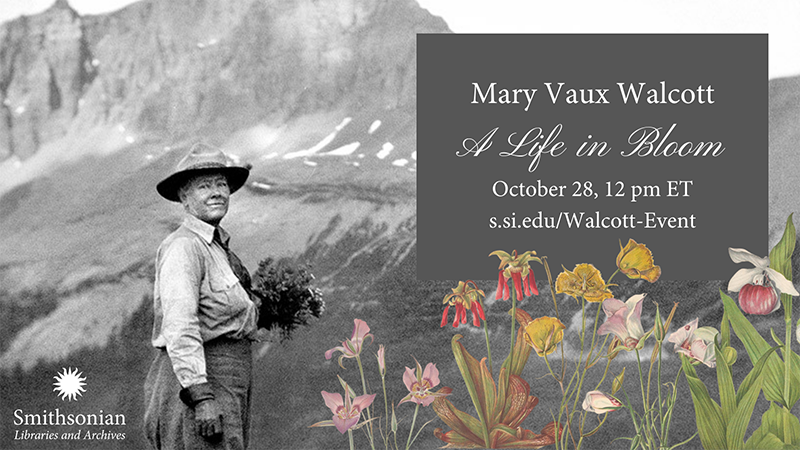
Featuring:
- Dr. Pamela Henson, Institutional Historian, Smithsonian Libraries and Archives
- Dr. Virginia Mecklenburg, Senior Curator, Smithsonian American Art Museum
- Dr. Rebecca Dikow, Research Data Scientist, Smithsonian Institution OCIO Data Science Lab
- Justin Kondrat, Lead Horticulturist for Smithsonian Garden Orchid Collection, Smithsonian Gardens
We are committed to providing access services so all participants can fully engage in these events. Optional real-time captioning will be provided. If you need other access services, please email SLA-RSVP@si.edu. Advanced notice is appreciated. This program will also be recorded and made available following the event.
Nature of the Book Online
Explore early handmade books through the myriad natural materials—animal, vegetable, and mineral—that went into their making. Nature of the Book shows what the use of these varied and sometimes surprising resources can tell us about the book, touching on questions of use, process, global trade, and economy. On display Online.
Music HerStory Online
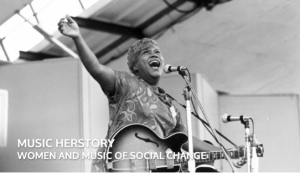 Women’s leadership in music and social change is central to the American story. Music HerStory explores these contributions through unique collections from the Smithsonian Libraries and Archives, the Center for Folklife and Culture Heritage, and more. Through March 24, 2025 at the National Museum of American History.
Women’s leadership in music and social change is central to the American story. Music HerStory explores these contributions through unique collections from the Smithsonian Libraries and Archives, the Center for Folklife and Culture Heritage, and more. Through March 24, 2025 at the National Museum of American History.
Smithson to Smithsonian
Smithsonian Libraries and Archives and the Smithsonian’s Center for Folklife and Cultural Heritage Unveil “Music HerStory”
The Smithsonian Libraries and Archives and the Smithsonian’s Center for Folklife and
Cultural Heritage open a new exhibition, “Music HerStory: Women and Music of Social Change” at the Smithsonian’s National Museum of American History June 22. “Music HerStory” will be on display through Feb. 20, 2024.
Women’s leadership in music and social change is central to the American story. From
people’s earliest musical encounters to the formation of complex social identities, the American
musical landscape would not be what it is today without the countless contributions of women
changemakers, groundbreakers and tradition-bearers. “Music HerStory” explores these contributions through unique media collections from Smithsonian Libraries and Archives, the Center for Folklife and Culture Heritage and around the Smithsonian.
The exhibition, presented in both Spanish and English, will feature Ella Jenkins, an awardwinning musician whose songbooks have taught children about a diversity of cultures and languages for over 50 years; Sister Rosetta Tharpe, the “Godmother of Rock ’n’ Roll” and a pioneer of spiritual music; Lucy McKim Garrison, an abolitionist musicologist who documented African American music in the 1800s; Queen Liliʻuokalani, the last sovereign monarch of Hawaiʻi, who was a gifted and prolific composer; and singers Dolly Parton, Kitty Wells and Loretta Lynn, who shaped the country music genre.
“With more than 16,000 musical instruments, 100,000 pages of sheet music, 80,000 recorded
music tracks, hundreds of books and hundreds of musical activities annually, the Smithsonian is among the world’s largest museums of music,” said Meredith Holmgren, curator of American
women’s music and this exhibition. “And yet, many of these musical resources remain unknown to the public. This is especially true for our music collections that relate to women’s history. Women have made incredible contributions to the history of music and social change. We are delighted to bring many of these stories to life in the exhibition.”
“Music HerStory” tells the powerful stories of women who used music to challenge gender
stereotypes; bring forth revolutionary self-expression; reimagine political and social change; push boundaries for the labor movement, women’s health and education; and deliver victories for temperance and suffrage activism. Objects on display include the Jean Ritchie’s dulcimer made by George Pickow (Viper, Kentucky, 1951), Elizabeth Cotten’s Folksongs and Instrumentals with Guitar (Folkways Records, 1958), Lydia Mendoza’s La Gloria de Texas (Arhoolie Records, 1980), Gustavus D. Pike’s The Jubilee Singers, and Their Campaign for Twenty Thousand Dollars (Boston and New York, 1873) and riot grrrl zines of the 1990s.
“We are thrilled to present women movers and shakers who forever altered the course of
American music,” said Tamar Evangelestia-Dougherty, director of the Smithsonian Libraries and Archives. “We honor their drive, their creativity, their advocacy and their achievement, painting a portrait of their long-standing influence through Smithsonian collections.”
From Mother Goose to Girl Power, Prohibition to the civil rights movement, women have
made their voices heard in the story of American music. Through rare and unique books, photographs, albums and recordings, “Music HerStory” captures their innovative contributions and courageous spirit.
Support
“Music HerStory” received support from the Smithsonian American Women’s History
Initiative. Special thanks to The Arhoolie Foundation and the DC Public Library.
Programs Smithsonian Folkways Recordings, Smithsonian Libraries and Archives and the Smithsonian’s American Women’s History Initiative co-present “Folkways @ Folklife: Alice Gerrard and Leyla McCalla,” an event in conjunction with the exhibition, Friday, June 24, at 7 p.m. on the Rinzler Stage at the Smithsonian Folklife Festival on the National Mall. Visit the event page for more details.
Additional public programs accompanying the exhibition will engage diverse audiences from
K–12 to adult, including workshops, lectures and hands-on sessions.
About the Smithsonian Libraries and Archives
The Smithsonian Libraries and Archives is an international system of 21 library branches and
an institutional archives. It maintains a collection of nearly 3 million volumes and 44,000 cubic feet of archival materials. The Libraries and Archives serves as an educational resource for the Smithsonian Institution, the global research community and the public. Locations are in Washington, D.C., Maryland, Virginia, New York City and the Republic of Panama.
About the Center for Folklife and Cultural Heritage
The Center for Folklife and Cultural Heritage uses the power of culture to increase
understanding, strengthen communities and reinforce our shared humanity through rigorous research, educational programming and community engagement. Through the Smithsonian Folklife Festival, Smithsonian Folkways Recordings, exhibitions, documentary films and videos, symposia, publications and educational materials, the center works to sustain traditional and expressive culture such as music, language and craft in a wide variety of locations around the world.
About the Smithsonian American Women’s History Initiative
The Smithsonian American Women’s History Initiative, “Because of Her Story,” is one of the
country’s most ambitious undertakings to research, collect, document, display and share the rich, complete and compelling story of women in America. Launched in 2018, the initiative seeks to create a more equitable and just American society by creating, educating, disseminating and amplifying the historical record of the accomplishments of American women. More information about the initiative, including exhibitions and public programs, is available online at womenshistory.si.edu.
Note to editors: Selected images from “Music HerStory” may be downloaded. For further information about the exhibition, visit the “Music HerStory” bilingual website.
 Download musicherstoryexhibition.pdf (188.31 KB)
Download musicherstoryexhibition.pdf (188.31 KB)
Smithsonian Names Tamar Evangelestia-Dougherty Director of Smithsonian Libraries and Archives

Tamar Evangelestia-Dougherty has been appointed director of the Smithsonian Libraries and Archives, effective Nov. 6. An expert in the stewardship, interpretation and acquisition of collections, Evangelestia-Dougherty brings a rich background driving public outreach and cultivating robust print and digital collections across diverse subject matters. Evangelestia-Dougherty will bring strategic leadership to the recently integrated Smithsonian Libraries and Archives, which is responsible for nearly 3 million library volumes and over 44,000 cubic feet of archival materials chronicling the history of the Smithsonian. She will oversee 137 employees, a national advisory board of 15 members, an annual budget of over $16 million and 22 library branches and reading rooms located in Washington, D.C., New York City, Maryland, Virginia and the Republic of Panama.
“The Smithsonian Libraries and Archives organization provides invaluable services that underpin the research, scholarship and programs of the Smithsonian,” said Lonnie Bunch, the Secretary of the Smithsonian. “Tamar’s expertise and leadership will accelerate our digital presence and help us reach new audiences while continuing to support our world-class scholarship.” “All work at Smithsonian Libraries and Archives arises from the central purpose of scholarship, intellectual curiosity and continuous engagement,” Evangelestia-Dougherty said. “As director, I look forward to inspiring our audiences, sustaining the success of our staff and reflecting the mission of the Smithsonian Institution through my leadership.” Evangelestia-Dougherty has a proven track record strengthening collections and digital initiatives. She is currently an associate university librarian at Cornell University where she initiated Cornell RAD, a new research hub for rare and distinctive collections. She is also a faculty member of the UCLA California Rare Book School. As director of collections and services at New York Public Library’s Schomburg Center for Research in Black Culture from 2013 to 2014, Evangelestia-Dougherty led collection and programmatic development of five curatorial divisions. At the University of Chicago’s Black Metropolis Research Consortium, she served as executive director from 2011 to SI-303-2021
2013 and as consulting archivist from 2007 to 2011. There, she successfully led initiatives to discover and make accessible archives related to the African American diaspora. In addition to her extensive work with rare and distinctive collections, Evangelestia-Dougherty is a published author and public speaker who has presented nationally on topics of inclusivity and equity in bibliography, administration and primary-source literacy. She currently serves on the boards of Digital Scriptorium and the American Printing History Association. Evangelestia-Dougherty holds a Master of Science in information science from Simmons University’s School of Library and Information Science in Boston and a bachelor’s degree in political science from the University of Houston.
Evangelestia-Dougherty succeeds Nancy Gwinn, who was the director of Smithsonian Libraries from 1997 to 2019, and Tammy Peters, who was the interim director of Smithsonian Institution Archives after the retirement of Anne Van Camp in 2018. Scott Miller, the Smithsonian’s Chief Scientist, has served as the interim director of Smithsonian Libraries and Archives since 2020. Smithsonian Libraries merged with Smithsonian Institution Archives in 2020.
 Download tamarevangelestia-doughertynamedsladirector.pdf (140.35 KB)
Download tamarevangelestia-doughertynamedsladirector.pdf (140.35 KB)
Four New Members Join Smithsonian Libraries and Archives Board
Media only: Liz O’Brien (202) 633-1522; obriene@si.edu Feb. 23, 2021
The Smithsonian Institution’s Board of Regents appointed John Chickering, Christopher Clark, Christopher Lee and Nick Santhanam to the Smithsonian Libraries and Archives Advisory Board. They join 13 prominent community and business leaders dedicated to building the Libraries and Archives’ collections, increasing digital initiatives, advancing education, progressing library and archival preservation, creating high-quality exhibitions and programs and securing a financial legacy.
“It is my pleasure to welcome four outstanding new members to the Smithsonian Libraries and Archives Advisory Board,” said Scott E. Miller, interim director of the Smithsonian Libraries and Archives and the Smithsonian’s chief scientist. “Invaluable leaders in their fields, their experience and guidance will tremendously benefit the Libraries and Archives’ continued growth as a critical global resource. We are fortunate to tap into their extensive wisdom and diverse perspectives.”
The Smithsonian Libraries and Archives Advisory Board consists of members from across the United States. The mission of the board is to help the organization to provide authoritative information, steward the Smithsonian’s institutional memory and create innovative services and programs for Smithsonian researchers, scholars, scientists, curators, archivists, historians and other staff, as well as the public at large.
John Chickering
John Chickering advises boards and senior executives on strategy, technology and operations. He has a track record of effectively bridging business operations and information technology to deploy diverse digital transformation solutions across large enterprises.
As a pioneer in the development of digital archiving solutions, Chickering’s work was cited in industry trade press and he wrote papers for peer-review publications. For the Department of Defense, he defined a system to store over 100 million engineering drawings across dozens of domestic sites.
For Fidelity Investments, he deployed a cross-enterprise digital archive solution. While serving as a chief information officer in Fidelity’s private equity portfolio, Chickering built out the technology for a corporate off-site records storage facility and was a principal thought leader in
forming Fidelity’s digital records archive strategy. He led a multi-year enterprise digital transformation initiative that migrated complex high-volume customer communications from paper to eDelivery.
Chickering’s board experience includes both fiduciary and advisory boards for commercial, educational and other non-profit institutions where he has held various executive committee positions, including chair. He is a Fellow of the Association for Intelligent Information Management and is an occasional speaker at industry conferences and seminars hosted in academia.
Chickering volunteers with several community service organizations and has led over 15 hurricane/storm restoration work teams on the ground in Mississippi, New York, Vermont and Florida. He holds a Bachelor of Science in marine engineering from the U.S. Merchant Marine Academy and an MBA from the University of Maryland.
Christopher Clark
Christopher York Clark joined Directorship as senior vice president and publisher in December 2002. In 2006, he was promoted to president and publisher of Directorship Services LLC. As senior director of Partner Relations and Publisher, he is presently responsible for the revenue development and conduct of NACD Directorship Magazine, NACD corporate governance forums and director roundtables. In addition, he currently heads the programming for NACD’s Leading Minds of Compensation Forum and NACD’s Leading Minds of Governance Conference. Further, he is the creator of NACD Private Company Directorship and the architect and day-to-day catalyst of NACD’s Power of Difference program.
Clark joined NACD following a decade of service at Forbes Inc. Most recently, he was vice president, sales for Forbes.com. Earlier he served as vice president and general manager of the Forbes Management Conference Group, a leading producer of senior-executive meetings. In this capacity, he oversaw P&L, sales, marketing, program development and logistics for all Forbes conferences. Prior to that position, he served as Forbes magazine’s financial services advertising director.
Presently, Clark is a member of the Broadridge Virtual Shareholder Meeting Best Practices Working Group, and a contributing member of NACD’s Flag and General Officer Advisory Council. He received a Bachelor of Arts from Denison University.
Christopher Lee
Chris Lee is a partner at FAA Investments, a private investment group focusing on real estate, early-stage companies and in-depth research on hedge funds and private equity managers. With home bases in San Francisco and Hong Kong, Lee and his partners allocate capital globally. He is fluent in English and Chinese.
Additionally, Lee is a board director with expertise in financial markets, risk management, governance and leadership development. Currently, he serves as an Independent Board Member with Matthews Asia Funds, the largest US Investment Company (’40 Act) with a dedicated focus on Asia Pacific markets.
Previously, Lee was an investment banker for 18 years, acting as managing director and divisional and regional heads at Deutsche Bank AG, UBS Investment Bank AG and Bank of America Merrill Lynch. He worked in global capital markets, managed derivative product development and provided equity sales and trading functions to institutional investors.
He is an advocate of sustainable enterprises and environmentally conscious projects, serving on various boards with a passion for promoting education, conservation, energy efficiency and sustainability. Lee also serves on the boards of University of California, Berkeley-Haas Dean’s Advisory Circle, African Wildlife Foundation, Hong Kong Securities and Investment Institute and Salzburg Global Seminar.
Academically, Lee is an associate professor of science practice at HKUST and teaches financial mathematics and risk management courses. He completed the AMP at Harvard University and holds a Bachelor of Science in mechanical engineering and an MBA from the University of California, Berkeley.
Nick Santhanam
Nick Santhanam is a senior Partner in McKinsey & Company’s Silicon Valley Office and leads their global industrials practice. Nick also leads their S5C (Sub $5 billion companies) practice. Nick serves industrials/industrial-tech companies on their end-to-end strategy and performance transformation efforts. He has led their work on “McKinsey on industrials,” “McKinsey on Packaging,” “McKinsey on flow control,” “McKinsey on food processing and handling,” “McKinsey on construction” and several other knowledge efforts, which are deep dives in various industrial micro verticals, to map the secular growth headwinds and tailwinds as well as what it takes for companies to create and capture value. He also hosts their annual CEO summits—Industrial CEO (GILS), Tech CEOs (T-30), Family-owned companies CEO (L-20)—as well as he the host and convener of their executive learning programs including board learning event on disruptions (NWDS), investor learning on disruptions (NWDS-I) and executive learning event on transformations (APT-30). In the past 36 months, he has led multiple successful transformations of companies, which has led to 200-500 basis points of margin expansion and significant shareholder value creation.
Prior to joining McKinsey, Santhanam worked as a technical manager at Taconic (a PCB/ceramics manufacturer), Petersburgh, New York. Prior to Taconic, he worked as a manufacturing engineer at Arlon in their Bear, Delaware facility.
Santhanam has a Master of Science in chemical engineering from University of Illinois and an MBA in strategic management and finance from the Wharton School, University of Pennsylvania. He graduated as a Ford and Palmer scholar from Wharton.
About the Smithsonian Libraries and Archives
The Smithsonian Libraries and Archives is an international system of 21 library branches and an institutional archives. It maintains a collection of nearly 3 million volumes and 44,000 cubic feet of archival materials. The Libraries and Archives serves as an educational resource for the Smithsonian Institution, the global research community and the public. Locations are in Washington, D.C., Maryland, Virginia, New York City and the Republic of Panama. Find out more at librariesarchives.si.edu.
# # #

